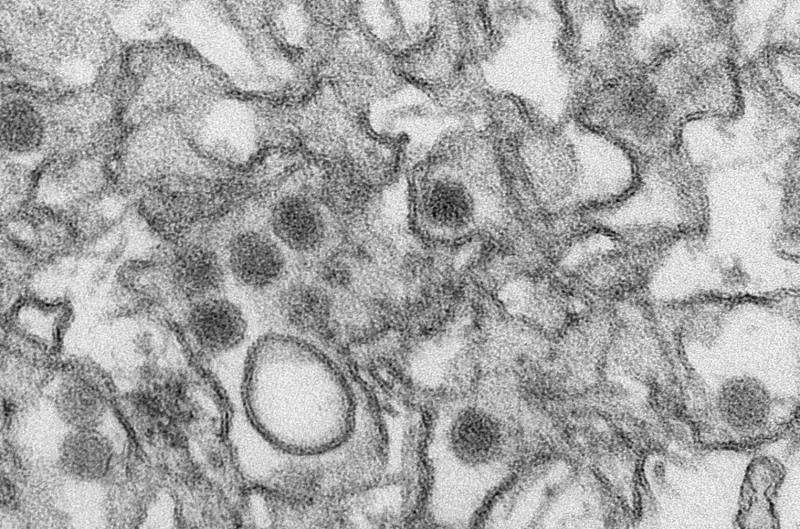Transmission electron micrograph (TEM) of Zika virus. Credit: Cynthia Goldsmith/Centers for Disease Control and Prevention
The protein that helps the sperm and egg fuse together in sexual reproduction can also fuse regular cells together. Recent findings by a team of biomedical researchers from the Technion-Israel Institute of Technology, Argentina, Uruguay and the U.S. show this protein is part of a larger family of proteins that helps other cells bind together to create larger organs, and which also allows viruses like Zika and Dengue to invade healthy cells.
For every sexually reproducing organism, sperm and egg fusion is the first step in the generation of a new individual. This process has been studied for more than 100 years in many organisms including humans, mice, insects, plants, sea urchins and even fungi. But the identity of the molecular machineries that mediate sperm and egg fusion remained unknown.
Now, the team led by Dr. Benjamin Podbilewicz, of the Technion Faculty of Biology, and Dr. Pablo S. Aguilar of Universidad Nacional de San Martin in Argentina, has demonstrated that the protein HAP2 – a long known player in sperm-egg fusion – is a protein that mediates a broad range of cell-cell fusion. Their findings were published recently in the Journal of Cell Biology.
HAP2 is found in plants, protists (e.g. algae, protozoa, and slime molds) and invertebrates, and is therefore considered an ancestral protein present at the origins of the first eukaryotic cells (cells with real nuclei). However, a closer look at HAP2 led the researchers to conclude that HAP2's roots are even older. Structural and phylogenetic analysis of HAP2 proteins revealed they are homologous to proteins used by viruses such as Zika and Dengue to fuse viral membrane to the membrane of the cell they invade.
According to the researchers, this means HAP2, FF and viral fusion proteins constitute a superfamily of membrane fusion proteins, which the authors named Fusexins (fusion proteins essential for sexual reproduction and exoplasmic merger of plasma membranes).
"Fusexins are fascinating machines that keep a structural core diversified to execute cell membrane fusion in very different contexts," says Prof. Podbilewicz. "Understanding the different structure-function relationships of fusexins will enable scientists to rationally manipulate cell-cell fusion in fertilization and tissue development. The added and very timely benefit is that it provides us greater understanding of how Zika and other viruses cause diseases in their target hosts."
The striking similarities between proteins that promote membrane fusion under very different contexts led the authors to dig into mechanistic details. Performing cell-cell fusion experiments, the researchers demonstrated that, like FF fusexins, HAP2 is needed in both fusing cells to promote membrane cell fusion. This bilateral requirement of HAP2 and FF fusexins differs from the viral mechanism of action, where fusexin is only present in the viral membrane (see figure).
The combined conservation of structure, sequence, and function imply that these proteins diverged from a common ancestor. Fusexins might have emerged 2-3 billion years ago to promote a primordial form of genetic material exchange between cells. Later, enveloped viruses took these fusion proteins to infect cells more efficiently. Finally, multicellular organisms adapted fusexins to sculpt organs like muscle and bone-repairing osteoclasts in vertebrates and skin and the vagina in worms through cell-cell fusion.
More information: Clari Valansi et al. HAP2/GCS1 is a gamete fusion protein homologous to somatic and viral fusogens, The Journal of Cell Biology (2017). DOI: 10.1083/jcb.201610093
Journal information: Journal of Cell Biology
Provided by Technion-Israel Institute of Technology























